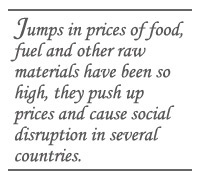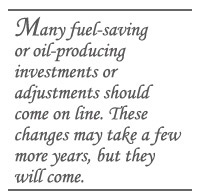Inflation Promises a Belt-Tightening Era
Inflation Promises a Belt-Tightening Era

MEDFORD: It should surprise nobody that the head of the US Federal Reserve says he’s worried about inflation. With gasoline, wheat and corn prices double and diesel, heating oil and rice prices about triple levels of last year, others are worried too. But the US consumer price index is up only 4 percent or so in the past year, and long-term bond US rates are also only 4 percent, suggesting much less concern about inflation
While astronomical food and fuel prices are easy to put into headlines, the shrinking number of jobs, falling real wages, and continuing financial fallout from bad mortgages and other loans all wait for their chance to grab attention. Should a sensible person worry more about “crazy” prices of oil or losing her job? Or both?

Growth in real GDP has been slow but not negative so far in 2008. The Federal Reserve states that two consecutive quarters of declining output – shorthand for a recession – are unlikely now that financial pressures are easing. That means that banks and other lenders are learning to manage their huge mortgage losses and normal inter-bank borrowing is coming back. They point to the low interest rate of 2 percent, the weak dollar helping exports and the fiscal stimulus package. No doubt they hope that some home foreclosures will be avoided by various schemes to write down problem mortgages to a realistic level.
Many economists are still doubtful. After all, crude oil prices will probably average $50 a barrel higher than in 2007, and at 20 million barrels used a day, that is subtracting $1 billion a day from purchasing power, most of which goes to foreign suppliers that buy little from the US. Meanwhile, home prices are down, consumer net worth dropped $1.7 trillion last quarter, wages are growing less than inflation and jobs are being lost. Merrill Lynch estimates that these negatives will subtract $775 billion this year from consumer spending – four times the stimulus package the Bush administration offered to citizens. Meanwhile, the Fed’s concerns with inflation mean that interest rates could soon start inching upward. Yet these factors do not cause as much worry as continuing concerns with the financial system.
Right now, one in eleven US mortgages is in default or in foreclosure. While subprime-mortgage delinquencies are particularly high, there’s a rapid rise in regular mortgages falling behind. Many analysts believe that housing prices will continue to fall and falling prices tend to increase the percentage of bad house loans. Many auto loans will also go under: High gas prices made SUVs and trucks less popular, and for many, the amount owed is worth more than the value of the vehicle itself. Home equity loans, credit-card balances and small commercial bank loans are all on the watch list. In a bad but plausible scenario, hundreds of billions more in bad loans could emerge and cause immense problems for banks and other lenders. This would tend to become self-sustaining and cause a recession or worse.

US exports are doing well in response to a weak dollar, but this is offset by the soaring price of oil. Taking January to April 2007 and 2008, non-oil exports rose $55 billion while much larger non-oil imports rose only $20 billion. So, the non-oil trade deficit shrank by $35 billion. But oil imports rose by $55 billion, more than offsetting the entire non-oil improvement. Virtually all of the increase in oil-import cost was due to rising prices. If the dollar weakens, oil prices could go up even more. The trade deficit is running at a rate of $700 billion a year. This is a large amount, and it would take a decided fall in oil import volume and/or prices for this to decrease by much. It’s unclear how much longer a deficit at these levels can be financed without further depreciation of the dollar or higher interest rates. US policymakers are “in a pickle” if they want to inject further stimulus, especially from the monetary side.
If the rest of the world economy kept growing fast and helped US export growth, the economy might thread this needle. But the EU and Japan look likely, as does the US, to grow only about 1.5 percent a year in 2008 and 2009, with perhaps most risks in the forecasts to the downside. Meanwhile, China is also concerned with inflation and tightening monetary policy – its stock market recently plunged 7 percent in one day.

But the jumps in prices of food, fuel and some other raw materials have been so high that even with a small weight in total output, they have pushed up prices and caused social disruption in several countries: Truckers have blockaded shipments in Spain; a government fell in Haiti, and demonstrations against reducing fuel subsidies in Malaysia and India all suggest that prices do not “simply” adjust. Meanwhile, the International Energy Association predicts that while demand will be less than it had forecast, so will supply, and perhaps to a greater degree. Investment banks predict $150 or $200 per barrel oil prices that would cause immense pain, while food production looks shaky with too much rain in the US grain belt and drought in Australia. Given the low levels of grain reserves, it’s possible that there could be yet another round of punishing price increases in grains, meats, milk, eggs, and other foods.
Bottom line? There could still be significant price pressures even if economies are soft or in recession. We seem to have come back to the future with the threat of stagflation.

But, as Mark Twain once said, history doesn’t repeat itself and instead rhymes. True stagflation requires that labor and management agree that inflation is likely to continue. This leads to a wage-price spiral, and labor accounts for most of costs. However, wages and fringes like medical insurance and pension payments are rising only 3 to 3.5 percent per year, while productivity seems to be increasing by 2 to 2.5 percent a year, so labor costs are not rising much. If labor continues to suffer real wage losses while oil and food prices rise, markets and consumers will adjust. In rich countries this will mean smaller cars, living closer to work, more use of public transport and less grain-fed meat. In poor countries that do not subsidize, the adjustments could be more painful.
Many fuel-saving or oil-producing investments or adjustments should come on line. These changes may take a few more years, but they will come. The steps to improve yields will take even longer, and so food prices may prove even more troublesome than oil.
So, there are real financial dangers ahead that might be hard to avoid, and if oil prices headed up to $200 a barrel soon, it would be impossible to avoid a world recession or worse. It is fascinating to speculate why prices are north of $120 a barrel now – are fuel subsidies leaking out to other countries? Are national government investors speculating in oil? Are investment banks and hedge funds buying up contracts? Perhaps these mysteries will eventually be unraveled.
But for now, the world can only try to adjust. And unfortunately for many in poorer countries it might mean adjusting to one meager meal a day.
David Dapice is associate professor of economics at Tufts University and the economist of the Vietnam Program at Harvard University’s Kennedy School of Government.